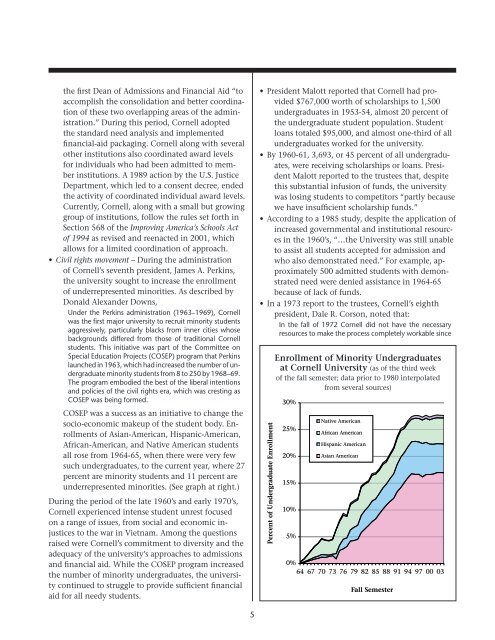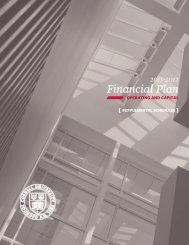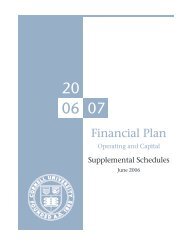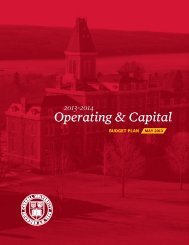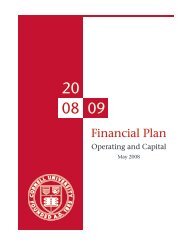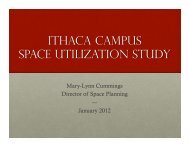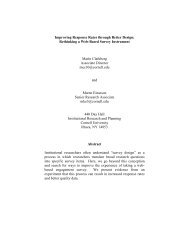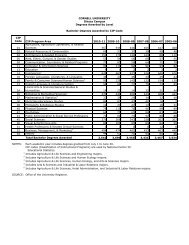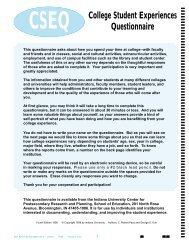Undergraduate Student Access - Cornell University Division of ...
Undergraduate Student Access - Cornell University Division of ...
Undergraduate Student Access - Cornell University Division of ...
You also want an ePaper? Increase the reach of your titles
YUMPU automatically turns print PDFs into web optimized ePapers that Google loves.
the first Dean <strong>of</strong> Admissions and Financial Aid “toaccomplish the consolidation and better coordination<strong>of</strong> these two overlapping areas <strong>of</strong> the administration.”During this period, <strong>Cornell</strong> adoptedthe standard need analysis and implementedfinancial-aid packaging. <strong>Cornell</strong> along with severalother institutions also coordinated award levelsfor individuals who had been admitted to memberinstitutions. A 1989 action by the U.S. JusticeDepartment, which led to a consent decree, endedthe activity <strong>of</strong> coordinated individual award levels.Currently, <strong>Cornell</strong>, along with a small but growinggroup <strong>of</strong> institutions, follow the rules set forth inSection 568 <strong>of</strong> the Improving America’s Schools Act<strong>of</strong> 1994 as revised and reenacted in 2001, whichallows for a limited coordination <strong>of</strong> approach.• Civil rights movement – During the administration<strong>of</strong> <strong>Cornell</strong>’s seventh president, James A. Perkins,the university sought to increase the enrollment<strong>of</strong> underrepresented minorities. As described byDonald Alexander Downs,Under the Perkins administration (1963–1969), <strong>Cornell</strong>was the first major university to recruit minority studentsaggressively, particularly blacks from inner cities whosebackgrounds differed from those <strong>of</strong> traditional <strong>Cornell</strong>students. This initiative was part <strong>of</strong> the Committee onSpecial Education Projects (COSEP) program that Perkinslaunched in 1963, which had increased the number <strong>of</strong> undergraduateminority students from 8 to 250 by 1968–69.The program embodied the best <strong>of</strong> the liberal intentionsand policies <strong>of</strong> the civil rights era, which was cresting asCOSEP was being formed.COSEP was a success as an initiative to change thesocio-economic makeup <strong>of</strong> the student body. Enrollments<strong>of</strong> Asian-American, Hispanic-American,African-American, and Native American studentsall rose from 1964-65, when there were very fewsuch undergraduates, to the current year, where 27percent are minority students and 11 percent areunderrepresented minorities. (See graph at right.)During the period <strong>of</strong> the late 1960’s and early 1970’s,<strong>Cornell</strong> experienced intense student unrest focusedon a range <strong>of</strong> issues, from social and economic injusticesto the war in Vietnam. Among the questionsraised were <strong>Cornell</strong>’s commitment to diversity and theadequacy <strong>of</strong> the university’s approaches to admissionsand financial aid. While the COSEP program increasedthe number <strong>of</strong> minority undergraduates, the universitycontinued to struggle to provide sufficient financialaid for all needy students.• President Malott reported that <strong>Cornell</strong> had provided$767,000 worth <strong>of</strong> scholarships to 1,500undergraduates in 1953-54, almost 20 percent <strong>of</strong>the undergraduate student population. <strong>Student</strong>loans totaled $95,000, and almost one-third <strong>of</strong> allundergraduates worked for the university.• By 1960-61, 3,693, or 45 percent <strong>of</strong> all undergraduates,were receiving scholarships or loans. PresidentMalott reported to the trustees that, despitethis substantial infusion <strong>of</strong> funds, the universitywas losing students to competitors “partly becausewe have insufficient scholarship funds.”• According to a 1985 study, despite the application <strong>of</strong>increased governmental and institutional resourcesin the 1960’s, “…the <strong>University</strong> was still unableto assist all students accepted for admission andwho also demonstrated need.” For example, approximately500 admitted students with demonstratedneed were denied assistance in 1964-65because <strong>of</strong> lack <strong>of</strong> funds.• In a 1973 report to the trustees, <strong>Cornell</strong>’s eighthpresident, Dale R. Corson, noted that:In the fall <strong>of</strong> 1972 <strong>Cornell</strong> did not have the necessaryresources to make the process completely workable sincePercent <strong>of</strong> <strong>Undergraduate</strong> EnrollmentEnrollment <strong>of</strong> Minority <strong>Undergraduate</strong>sat <strong>Cornell</strong> <strong>University</strong> (as <strong>of</strong> the third week<strong>of</strong> the fall semester; data prior to 1980 interpolatedfrom several sources)30%25%20%15%10%5%Native AmericanAfrican AmericanHispanic AmericanAsian American0%64 67 70 73 76 79 82 85 88 91 94 97 00 03Fall Semester5


